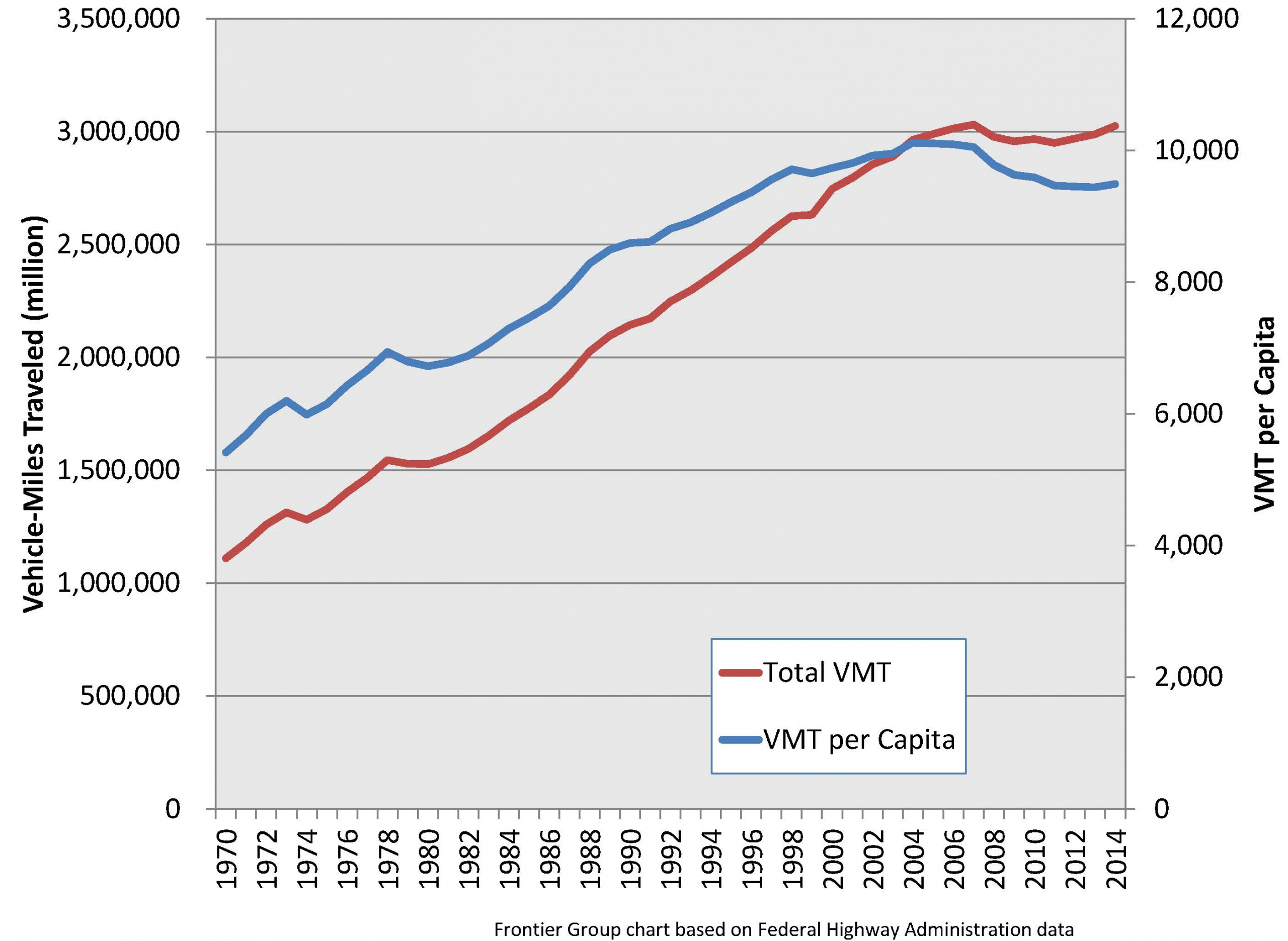
Driving Trends: 2014
Americans continued to drive fewer miles on average in 2014 than they did 17 years earlier, in 1997.
The Federal Highway Administration has begun releasing portions of its 2014 Highway Statistics report, the government’s flagship report on the status of the nation’s highway system. The data provide an opportunity to revisit where we stand in the evolution of mobility patterns in the United States.
Vehicle Travel
In 2014, the number of vehicle-miles traveled per capita increased by 0.5 percent, the first such increase in a decade.[1] Despite the increase, Americans continued to drive fewer miles on average in 2014 than they did 17 years earlier, in 1997. VMT per capita remained about 6 percent below the 2004 peak.
Total VMT increased for the third consecutive year to 3.026 trillion miles, just short of the all-time peak in 2007.
An interesting side note is that the newly published data for 2014 represent an apparent 0.5 percent downward revision in VMT from the monthly figures provided in the FHWA’s Traffic Volume Trends series of reports.[2] So, while driving did increase in 2014, it likely didn’t increase quite as much as we previously thought it had. VMT has increased rapidly in 2015 – the fastest rate of growth in at least a decade – though total monthly figures for 2015 can be expected to be adjusted downward based on the revised 2014 data.
Vehicle-Miles Traveled: Total and Per Capita (Source: FHWA, Census Bureau)

Licensed Drivers
In recent years, the share of Americans with driver’s licenses has been decreasing, with the decline steepest among younger Americans. In 2014, the share of Americans with a driver’s license ticked up slightly, but it remains below the peak of the late 1990s. Licensure rates among both Americans under 19 and those 20 to 24 years old continued to decline, in line with recent trends, though it is important to be cautious in interpreting these numbers as questions have been raised in the past about the reliability of FHWA’s licensure data for younger people.
Vehicles
The number of registered vehicles per capita increased in 2014 to its highest level since 2009, though it remains below the 2007 peak. Expect this figure to rise amid near-record car sales in 2015.
Licensed Drivers and Registered Vehicles per Capita (Source: FHWA)

Commentary
Data for 2014 show several trends that would become plainly evident in 2015: rising per-capita VMT and increasing vehicle sales and ownership. The question going forward is whether the increase in motorization in 2014 and 2015 represents a bump in a bumpy plateau or a return to the previous (pre-2004) trend of steady, year-over-year growth in vehicle travel.
The precise confluence of factors that fueled the increase in driving over the last year and a half – including rock-bottom gas prices and ultra-low interest rates and looser lending terms for new and used cars – is unlikely to be permanent, though exactly how long it will last is anyone’s guess. We can expect year-over-year growth in VMT to slow in the months to come (relative to last year’s torrid pace), now that we are more than one year removed from the collapse in gas prices that occurred in the fall of 2014. Indeed, recent data from the Energy Information Administration show that year-over-year growth in gasoline demand has begun to slow.
Longer-term indicators – workforce participation, demographics, trends in urbanization – continue to suggest that future growth in overall vehicle travel will be moderate and growth in per-capita travel minimal … at least until we get to the next “game changer,” whether it be driverless cars or the next unanticipated geopolitical or economic event.
When we started paying close attention to VMT trends about five years ago, our initial impulse was to question the assumption that per-capita vehicle travel must always and ever increase – an assumption that drove transportation policy and the public narrative about it for decades. Despite the rise in driving in 2014 and 2015, there remain very good reasons to continue to question that assumption, and to shift our thinking about transportation policy and planning accordingly.
Lastly, it is important to understand that monthly data on VMT are noisy, imperfect, and prone to frequent revision. Those data provide us with important information, but need to be taken with a healthy dose of salt.
[1] Previous FHWA VMT estimates suggested that there may have been a slight rise in per-capita driving earlier in the 2010s. The most recent revised annual data now suggest that this was not the case, though the declines in per-capita in 2012 and 2013 were so small that growth could fairly be characterized as “flat.”
[2] Traffic Volume Trends (TVT) uses the most recent available VMT estimate from Highway Statistics as the base for its monthly travel estimates. For example, the December 2014 TVT report, which used Highway Statistics 2012 as its base, estimated total VMT for 2014 to be 3.015 trillion miles. The January 2015 report, which used Highway Statistics 2013 as its new base, revised that figure upward 0.8 percent to 3.039 trillion miles. Highway Statistics 2014, which relies on reporting from state DOTs and is the official measure of annual VMT, has revised that figure down by 0.5 percent to 3.026 trillion miles. The revised final 2014 figures will likely be incorporated into the Traffic Volume Trends report in coming months, as the FHWA typically does at this time of year, resulting in downward revisions in total monthly VMT estimates for 2015.
Authors
Tony Dutzik
Associate Director and Senior Policy Analyst, Frontier Group
Tony Dutzik is associate director and senior policy analyst with Frontier Group. His research and ideas on climate, energy and transportation policy have helped shape public policy debates across the U.S., and have earned coverage in media outlets from the New York Times to National Public Radio. A former journalist, Tony lives and works in Boston.
